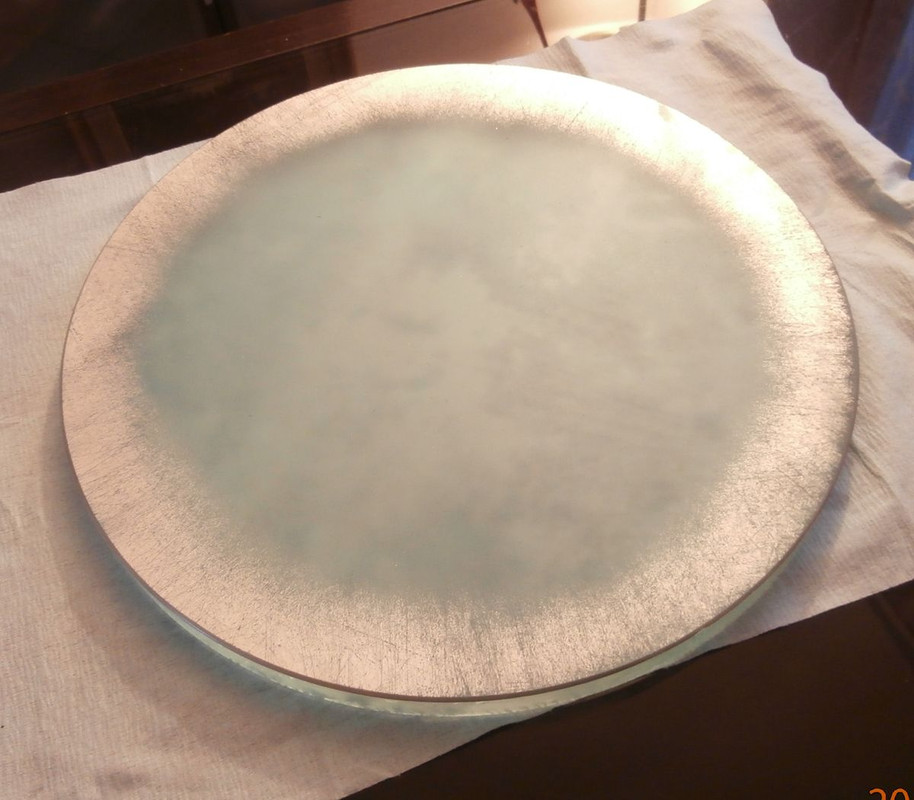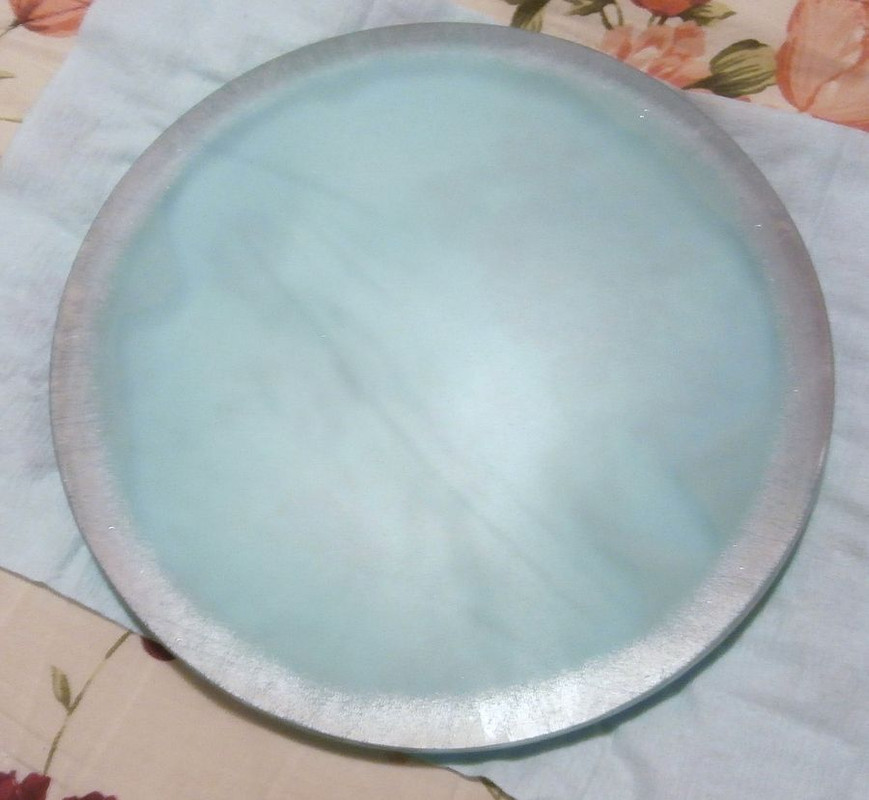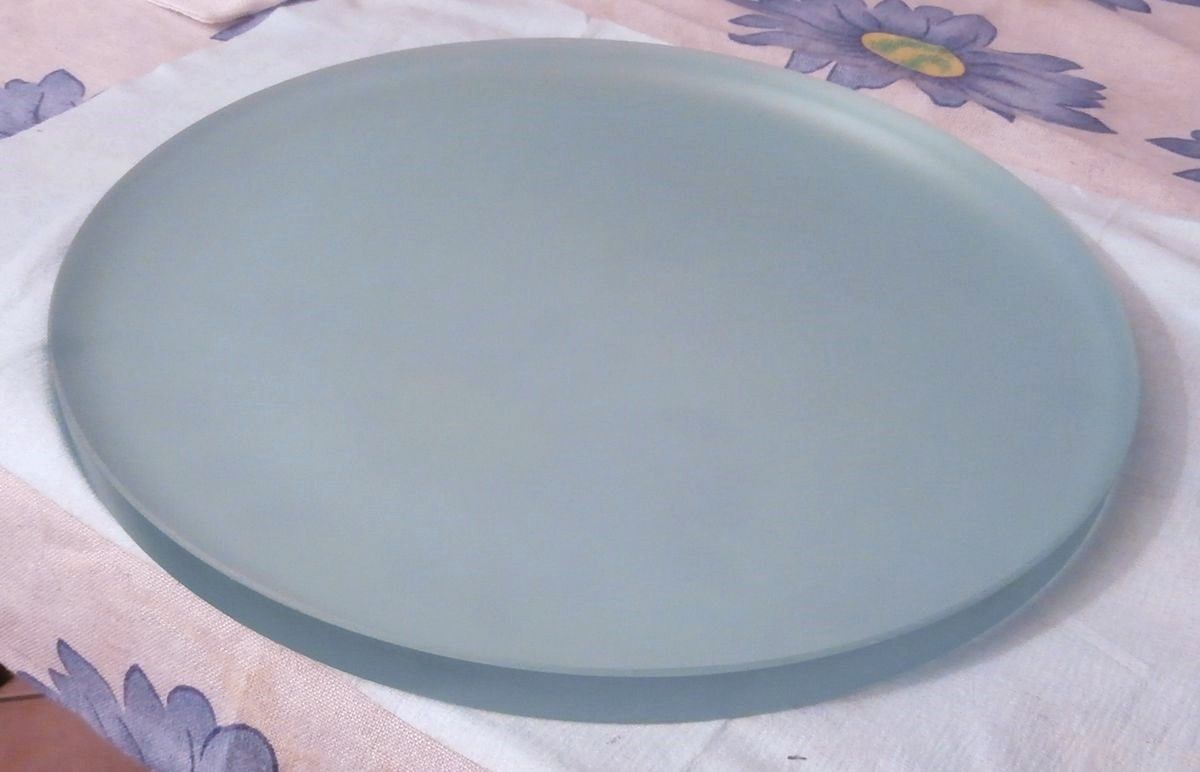- This topic has 142 replies, 6 voices, and was last updated 9 years, 6 months ago by
Giulio TiberinI .
-
AuthorPosts
-
29 December 2014 at 17:50 #5327
During these holidays year-end I have been caught by a worsening grattavetrite.

therefore, in the throes of withdrawal from abrasive, I decided to start working on the primary project I have in mind for a while’ of time:
The final goal is the construction of a Cassegrain configuration Ritchey-Chrétien telescope “Dobsonizzato”, which I will publish the project as soon as I finished arranging some construction details, for now I think the optics, starting from the primary.
The processing of a Cassegrain system is one of my greatest ambitions grattavetro, since I started this adventure, I also like the idea of experiencing a Cassegrain solution for Dobson that, as far as I know, It was carried out by only a few “foolhardy” and never in RC configuration, it is clear that I have no claim to “innovation” , God forbid, just the taste of dark path and explore a little known, to see where it will lead…I will keep updated the topic by inserting each time processing all updates, obviously starting from the optical design parameters until the final stages of “hyperbolization”, then we will think to the secondary…
Any suggestions / criticism / advice will surely be invaluable as the know-how of this particular construction company is yet to be built for me, together with the mirror…
29 December 2014 at 18:32 #5328It will certainly be a long and difficult adventure, but now the die is cast

In fact, I decided ( it was a difficult decision ) of “to recycle” the mirror 300 my current Dobson from which also will use some parts for the construction of the new telescope, also the third Dobson parked at home would inevitably marked the end of my over ten-year marriage relationship !
) of “to recycle” the mirror 300 my current Dobson from which also will use some parts for the construction of the new telescope, also the third Dobson parked at home would inevitably marked the end of my over ten-year marriage relationship !Meanwhile Here are the optical configuration data:
Primary: hyperbolic , diameter 300 mm F 2.5, arrow 7.35 mm ,conic constant -1.11
secondary:hyperbolic convex, diameter 106 mm, radius of curvature 750 mm, conic constant -5.12
overall system focal 2250 mm F7.5If in the meantime someone you had asked how do you take away the aluminizing by a mirror, I can assure you that with carborundum 80 It comes away that it is a wonder !!!

Here's how it looks after the mirror 3 sessions chordal fine 80.
clearly the edge is not reached by the machining with the chordal, there is to dig even two millimeters abundant until almost the arrow achievement and change of grain / passed.
31 December 2014 at 16:37 #5330Massimo will do my best wishes for the continuation of this on your own initiative
 (even to say here that you're switching to a different level than newton) that he will follow with great interest because sooner or later I'll start certainly a challenge of this kind. In which, however, I want to start using the machining in a much more consistent…
(even to say here that you're switching to a different level than newton) that he will follow with great interest because sooner or later I'll start certainly a challenge of this kind. In which, however, I want to start using the machining in a much more consistent…
Wow, certainly be able to fit a parabolizzaree f4 is already a challenge, I dare not think iperbolizzare a f2.5.
Sub-diameters required would say, vero?
A question, what method do you use to test the secondary?
 31 December 2014 at 17:57 #5332
31 December 2014 at 17:57 #5332Thanks for the good wishes Mirco, I'll need it…

And, mandatory sub, although I will try to get to until shiny with the full diameter.
For tests on the secondary, the choice is almost inevitable, I will use the method of analysis of the interference fringes through concave caliber described in “Bible” of Lecleire, including Giulio, in addition to providing me with the original version it was also concerned to make me the translation in Italian as you know, does not exist !!! Mythical Giulio !
However, there will be time for the secondary, for now they are still in the phase of the study of sacred texts..processing Update:
reached 6 mm depth ( I started by 4,85 mm del 300 F3.8) , with 17 Dried chordal “ipercompressa” ( the weight of the body on the palm of the hand at the center of the mirror, very close to the edge of the tool, abrasive almost a teaspoon “dry” , only three spurts of spray, the lens past generated a high noise, almost annoying, However, being very effective !
During the past, due to the depth reached, the mirror begins to take on a very inclined position, at which point I had to put a plywood disc beneath the tool to prevent the edge of the mirror from touching the supporting surface, when it is removed from above the tool.
In the edge it is still present a crown that maintains its aluminizing:
I would say to “rough guess” with this depth we are at a focal ratio 3.2, yet 1,3 mm and we…
5 January 2015 at 19:20 #5337Massimo're just decided Party!!
Well, A good start…It ends up better ( because the work here is not so short).
because the work here is not so short).I know only very superficially Cassegrain variants; Ritchey Chretien; Dall Kirkham e Pressman Camichel, for having read something here and there.
It means that your work will be a good reason to go into that…And I my “typhus” it is assured
The only thing I remember is recommended drilling the primary before his favorazione, if you do not think of a fire deflected by a tertiary.
5 January 2015 at 19:56 #5338Thanks for cheering Giulio, I thought to pierce the mirror after the fine abrasives before polishing, “tappando” subsequently the hole for further processing. I am sure that the drilling with the Waterjet does not subject the glass to particular mechanical stress, and ensures a clean cut and devoid of deformations to the edge.
In any case the diameter of the hole will be smaller than the area “hidden” from the secondary lens hood which will have a diameter of 135 mm, while the secondary will be 106 mm for a resulting CPL 31 mm .
Considering that the primary hole will not exceed 80 mm, there is a good margin of tolerance for the deformations to the inner edge that may also appear during the hyperbolization.I reached 7 mm depth, for an equivalent focal ( regularized either stored once again form ) of about 785 mm ( against 750 project ) for a net diameter of the chamfer 297 mm.
I think to stop here with the excavation and the chordal, I will not risk “go along” and generate a shorter focal length of F2.5 , proceeding with abrasives should get close to that required much.
It also need not the primary is absolutely accurate ( f2.5 or F2.6 makes little difference ), is in fact the secondary that must be brought to exact focal depending on the focal length of the primary.
So the project itself will be optimized once completed and measured the primary, obtaining the exact values for diameter / focal / conic constant of the secondary and relative distance from the primary. All of these values should instead be made with the utmost precision.for lovers of statistics:
excavated 2,2 mm total with the chordal-grained 80, with 45 wets.6 January 2015 at 15:16 #5340…..excavated 2,2 mm total with the chordal-grained 80, with 45 wets.
Interestingly Soo (and I assume “atletico”..).
The argument I make a lot of technical questions, seeking adequate answers. One of which is: What is the importance of “constant deformation b” in sheet or in the Foucault test evaluation program.
The text of Texereau in this regard it is interesting, but I do not see the connection that my poor single neuron would like to find.
I explain better my current drama: If Foucault I have a reference parabola that responds to the formula Hm ^ 2 / R; A formula which will have to pay a hyperbola reference?(..Maybe it is also a simple thing…But my “Ignorance always speaks loudly” , and thus it prevents me focus usefully, suggesting new concerns
 ).6 January 2015 at 15:59 #5344
).6 January 2015 at 15:59 #5344Giulio, I actually think it's much more simple as it may seem ( if I understand your question ), I'll explain:
whatever software, or manual calculation, must start from an equation of the conical in parametric form in which the constant relative, It defines an ellipse for “-1<C<0” , parable for c = -1 and for hyperbole “C<-1”When we build our parable we set the value of the constant exactly -1, (the resulting equation can be simplified in the canonical form of the parabola ), foucault analyze the test results and we will have some error defined in fractions of lambda.
This error is no more than ( as you know better than I. ) the deviation from our theoretical parable. If hypothetically we “excavated” too much, the resulting curve will be defined by a conic constant that will not be more c = c = -1 but -1-(mistake).
For example, if C = -1.01 it will be already in the field hyperbolic conical although we will have a truly negligible error and an almost perfect mirror.
To build our hyperbole, we must not do is replace the manual foucault software / computing, the value expected from the project for the conical constant of our hyperbole, in my case c = -1112, and measure the error in testing as we would do normally in the parable.
6 January 2015 at 16:25 #5347Indeed it would make sense. Given even the infinitesimal differences that would arise at the practical side as a deviation from the parable.
Thanks Massimo. I see a little’ more light! 9 January 2015 at 21:15 #5366
9 January 2015 at 21:15 #5366Regularized the shape with the passage to the grain 120, 25 dried to eliminate the “bubble” central and reach the edge in which it was gradually thinning the crown with the residue of aluminizing.
We take this opportunity to give a “ripassatina” the chordal for those who had tuned in the art grattavetraria only now
 :
:
During the past chordal the center of the mirror is explored in an unusual way, because all the pressure is concentrated on it, in the same way the tool edge undergoes a forced lowering generating a form far away from the sphere on both surfaces,
We will have so that the mirror will have a sudden central depression while the tool will maintain a center “dish” and a major depression at the edges.
By overlaying the two glasses we will have that the contact points are coated on the intermediate zone that does not yet have an adequate curvature, while the edge and the center does not coincide.Applying the past 1/3 COC are unable to stabilize the shape of the mirror and the tool towards that spherical , maintaining the depth at the center reached arrow.
Then, returning the mirror in processing, I have regularized form with the grain 120 as the mirror possessed its original curvature to F3.8 from which were excavated other two millimeters to reach the desired depth.
If I had started from flat glass, This regularization should have taken place largely through the use of grain 80.The 25 Dried have still added more 0.15 mm at a depth which reached 7.2 mm (scarce) for a radius of curvature , measured with the “Deabis method” of 1540 mm, very close to 1500 project. I think with successive grits we could gain another tenth of a millimeter bringing the closer bend radius, if not equal, to the project.
I also regenerated chamfers that you were a little’ thinned, now they have an area of about 2 mm for an effective diameter of the mirror of 297.5 mm.
It looks like this time the mirror , after the first three dried with 220: 9 January 2015 at 21:22 #5367
9 January 2015 at 21:22 #5367Beautiful area!.
You still central bubble (difference of curvature between mirror and tool) , or you have removed with the grain 120?9 January 2015 at 21:33 #5368The bubble “disappearance” 21a toward the annoyed with the 120, leaving the place to a series of microbubbles “striate” spread evenly, which have become even more “micro” after the passage with 220.
Now what are you doing I think Giulio, in the next few days I will take pictures during the abrasive processing to make some assessment with examination of the regularity of form through the analysis of “bolle”. 10 January 2015 at 12:44 #5369
10 January 2015 at 12:44 #5369I find this a very good idea:
Certainly the evidence on the progress of regularization and disappearance of bubbles, It is extremely interesting, because those who work a mirror, when it gets to that initial but important point of his labor, We often question how long it takes to see a result that is comforting on the good quality of its efforts.10 January 2015 at 23:18 #5370Hi Massimo, Just looking around the ground hard…I see with pleasure that the work is progressing shipped…

Would you put a picture in which one can see the extent of the arrow 7 mm…I like a lot that kind of photo… 11 January 2015 at 2:11 #5374
11 January 2015 at 2:11 #5374I can not take a picture in which one can see the curvature, So I made a video

At one point I used a gauge should be measured on a cigarette, ( cigarettes have a diameter of exactly 7 mm ), the gauge was then taken to measure 7,2 mm, In fact, the cigarette is there a little’ “long”.
Since you like these kinds of photos / videos, You might want to verify the depth measurement by measuring the timing of an oscillation and calculating the required height with respect to the center of the mirror, to provide the roll of tape the potential energy to travel at that particular delta T a mirror diameter. ( simple kinematic calculation of Physics 1)
If then, we want to be more precise, I could provide the tape rolling friction coefficients ( glass you know ..) its dimensions and weight, and display calcolarti the moment of inertia and further verify the depth of the total of damped oscillations until the stillness . ( calculating a bit’ more complex rational mechanics )
obviously…I'm kidding!


-
AuthorPosts
- You must be logged in to reply to this topic.